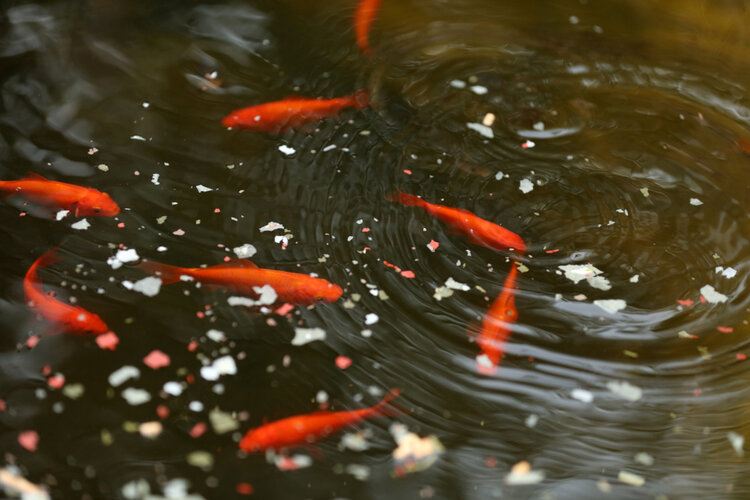Goldfish are a widely bred variety of fish that are a species of carp. Smaller varieties of goldfish are descended from the Prussian carp and currently highlight all kinds of colors, eye shapes, and different types of fins
Goldfish are some of the hardier species of decorative fish. Many varieties are tough enough to withstand the harsher climate of an outdoor pond. Most of these goldfish can withstand shallow depths, cold temperatures, and even brief hours of freeze over as long as they have enough oxygen to survive.
The 8 Types of Goldfish for Ponds
1. Common Goldfish
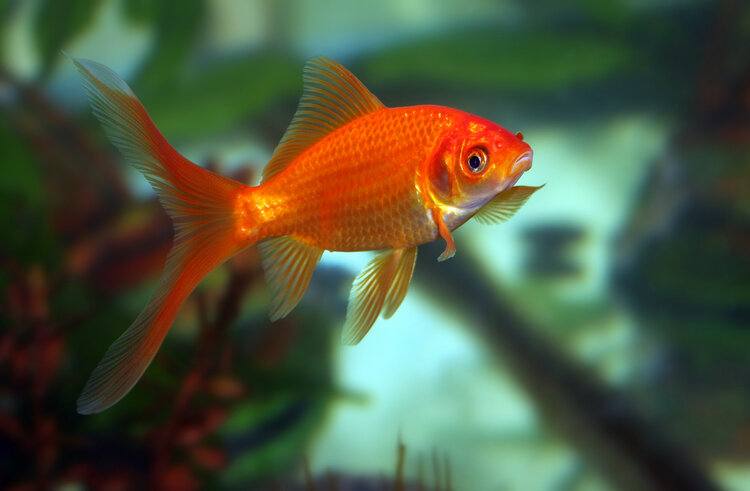
The Common goldfish comes in many types of oranges, blacks, bronze, red, and whites. They are also one of the hardiest species of freshwater fish that have been domesticated. Goldfish are typically known for being indoor fish, however, they have the capacity to survive outdoors and decorate your outdoor pond.
Common goldfish are medium-sized domesticated fish, growing up to 12 inches long when they live in well-filtered water. They can potentially live for decades, especially with ample space to swim and food to eat in a larger outdoor pond.
2. Comet
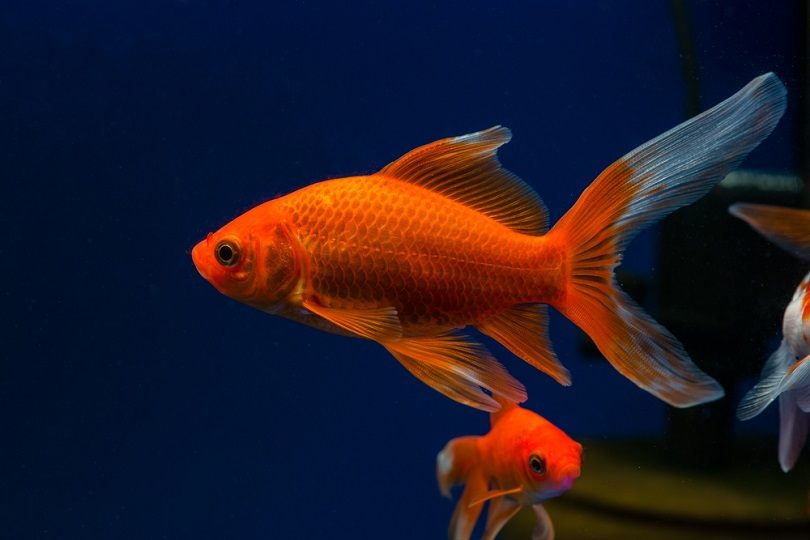
Comet goldfish are unique because they are the only type of goldfish created in the United States. They were named “Comet” due to their long tails that trailed after them like the tail of a comet. They can be as long as half of the fish’s entire body. These are also not a good fish to have with others since they are aggressive feeders.
Unlike the Common goldfish, Comets are often longer than them, sometimes growing over 12 inches, and much more slender. They come in a wide variety of colors, including red, black, orange, and white. Typically, their bodies have at least two colors on them, with some of the darker versions of the fish being the most popular. They can live for 14 years or more and are easy to find.
3. Wakin
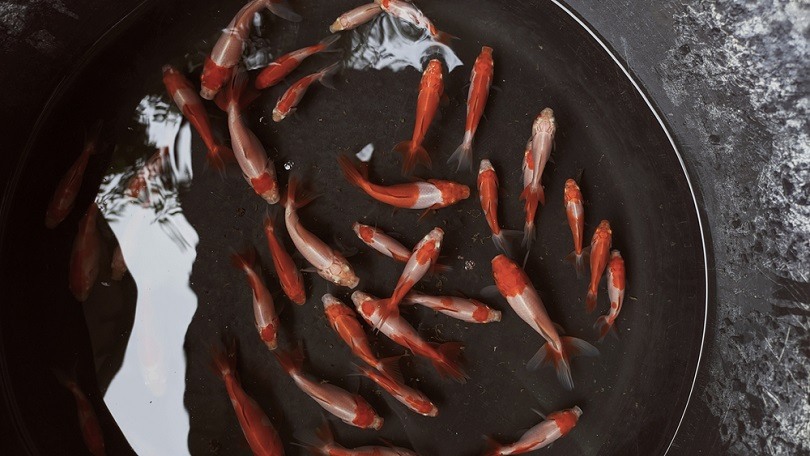
Wakin goldfish are a relatively new type of goldfish that are quite hardy. They can survive both in an outdoor pond or an aquarium. They look similar to the Common goldfish in shape, and they grow to a similar length. These fish are not suitable to live with other goldfish since they are aggressive feeders and crowd other species out from the surface.
The primary difference between the Common and the Wakin species is the shape of their caudal fins. They form a long and attractive fan shape and are known for their bright orangey-red and white markings covering their whole body. They can grow up to 10 inches long and are an excellent size to include in a pond.
4. Shubunkin
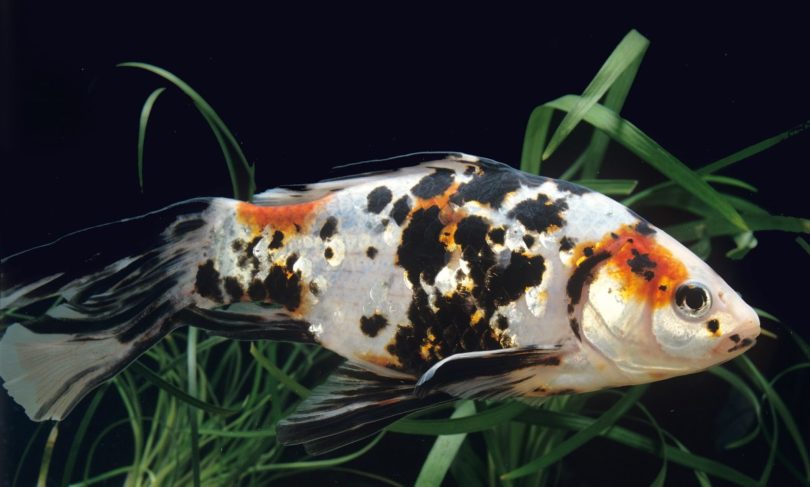
The Shubunkin goldfish is a Japanese-bred fish with a beautiful combination of red, orange, and white with black spots mottled across their bodies and fins. The word “shubunkin” means “red brocade” in Japanese, and they stand out as a unique calico goldfish. They can even come in a light blue color. These fish are also very aggressive eaters
Some hubunkins have transparent scales that make parts of their bodies look reflective or “see-through”. All of their fins are long and flowing, reminiscent of the form of old Japanese dress. They are also larger than the previous three fish, growing up to approximately 18 inches long. They can happily survive both in aquariums and ponds.
5. Black Moor
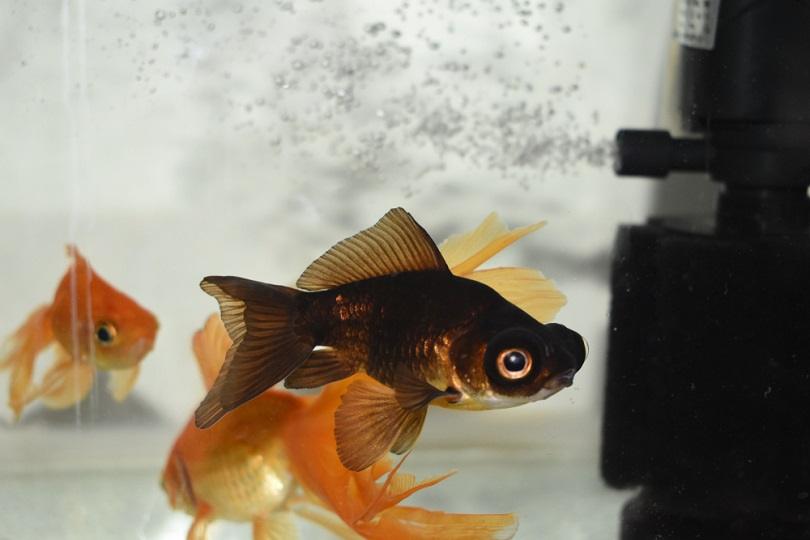
Black Moor goldfish are larger and more awkward-looking than some of the more elegant fish featured above. They have squat, thick bodies, a triangular dorsal fin, and a fan-shaped back fin. Perhaps most distinctive are their eyes. Their bodies seem to jut out from either side of their head
As the name would suggest, Black Moors are almost always entirely black. They are slower fish. Put them in a pond with other fish, but not faster ones like the Shubunkin, Comet, or Wakin since they will quickly starve. They can grow up to 10 inches long, and the shape of their eyes gives them limited vision.
6. Ryukin

The Ryukin is an interesting species that was derived from the fantail. They carry over most of the physical characteristics except that they have a more remarkable ability to survive. These fish have massive bodies and smaller fins in comparison. They retain the fantail, and it can vary widely in length. Their large mass makes them slow in the water, and so you should not pair them with faster fish like the Shubunkin or Comet.
The Ryukin is a glutinous feeder and is not picky at all. They will even eat some of the plants if they are still hungry. They can live for up to 15 years and only grow about 6-8 inches long, although their body mass makes up for their lack of length.
7. Oranda

The Oranda goldfish offers the best variety of many different kinds of fish. They come in many different colors, orange, yellow, white, red, and black. They can even be calico, mottled with all of them at once. These fish have large bodies and are an interesting spectacle with their bulbous heads, appearing like they have overly large brains.
The Oranda goldfish is another type of fantail and has a large triangular dorsal fin with flowing bottom fins to boot. They are larger, meaning they are slow and should not be paired with the faster fish at the top of the list. They will continue to grow until they are around 2 years old, and even with large bodies, they still grow up to 12 inches long. They need plenty of space in their outdoor pond and do not tolerate dirty or unkempt water.
8. Fantail

The Fantail goldfish is the most typical fantail variety that we have had around for many years. They can be a challenge to care for if you are a beginner, and thus only should be used after getting accustomed to having live goldfish in your pond. They are quite hardy and can even tolerate some missed feedings.
The largest challenge with Fantail goldfish is their lack of tolerance towards experiencing extended periods of living in cold water. In northern climates, these goldfish need to be taken inside if you want them to survive. If you do so, they can live for up to 10 years. They are slightly smaller goldfish, naturally only growing to be 6-8 inches long.

Conclusion
From speeding bullet-like goldfish to large floaters, there are many different looks that you can cultivate for the members of your outdoor pond. Caring for them properly, like feeding them on time and cleaning out the pond when needed, guarantees a healthy aquatic system for many years to come.
Featured Image Credit: Andrea Geiss, Shutterstock
